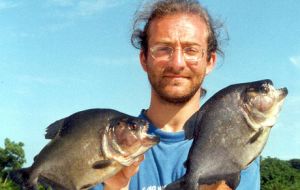MercoPress. South Atlantic News Agency
Unusually low temperatures empties Bolivian rivers of fish
 Michel Jégu, one of several international researchers analyzing the phenomenon
Michel Jégu, one of several international researchers analyzing the phenomenon With high Andean peaks and a humid tropical forest, Bolivia is a country of ecological extremes. But during the Southern Hemisphere's recent winter, unusually low temperatures in part of the country's tropical region hit freshwater species hard, killing an estimated 6 million fish and thousands of alligators, turtles and river dolphins.
Scientists who have visited the affected rivers say the event is the biggest ecological disaster Bolivia has known, and, as an example of a sudden climatic change wreaking havoc on wildlife, it is unprecedented in recorded history.
“There's just a huge number of dead fish” says Michel Jégu, a researcher from the Institute for Developmental Research in Marseilles, France, who is currently working at the Noel Kempff Mercado Natural History Museum in Santa Cruz, Bolivia. “In the rivers near Santa Cruz there's about 1,000 dead fish for every 100 meters of river.”
With such extreme climatic events potentially becoming more common due to climate change, scientists are hurrying to coordinate research into the impact, and how quickly the ecosystem is likely to recover.
The extraordinary quantity of decomposing fish flesh has polluted the waters of the Grande, Pirai and Ichilo rivers to the extent that local authorities have had to provide alternative sources of drinking water for towns along the rivers' banks. Many fishermen have lost their main source of income, having been banned from removing any more fish from populations that will probably struggle to recover.
The blame lies, at least indirectly, with a mass of Antarctic air that settled over the Southern Cone of South America for most of July. The prolonged cold snap has also been linked to the deaths of at least 550 penguins along the coasts of Brazil and thousands of cattle in Paraguay and Brazil, as well as hundreds of people in the region.
Water temperatures in Bolivian rivers that normally register about 15 ˚C during the day fell to as low as 4 ˚C. Hugo Mamani, head of forecasting at Senamhi, Bolivia's national weather centre, confirms that the air temperature in the city of Santa Cruz fell to 4 ˚C this July, a low beaten only by a record of 2.5 ˚C in 1955.
Often, when cold weather causes fish deaths in lakes, the mortalities are directly due to hypoxia, when oxygen levels are too low to supply the animals' cells and tissues. This is because the colder surface temperatures can reduce mixing in the water column.
“When fish die, it's usually not a single stressor, but multiple stressors interacting,” says Steven Cooke, an aquatic ecologist at Carleton University in Ottawa, Canada, who last year wrote a review of cold shock in fish. “So, if cold shock or cooler temperatures are being implicated in mortality, there's probably something else going on as well.”
Most of the research in the field of cold shock in fish has been carried out on rivers in temperate climates, rather than tropical ones. For example, fish in temperate rivers often die when a power station pumping warm water into a river suddenly shuts down.
Jégu has another hypothesis. He thinks that the burning of farmland around Santa Cruz, a regular part of the farming cycle locally, has occurred at particularly high levels this year. That might have been a contributing factor in the fish deaths, possibly because the smoke added to river pollution.
“We hope to secure financing for these studies to find out why the fish are dying,” he says. With luck, and money, these will start in October. (Naturenews).




Top Comments
Disclaimer & comment rulesCommenting for this story is now closed.
If you have a Facebook account, become a fan and comment on our Facebook Page!